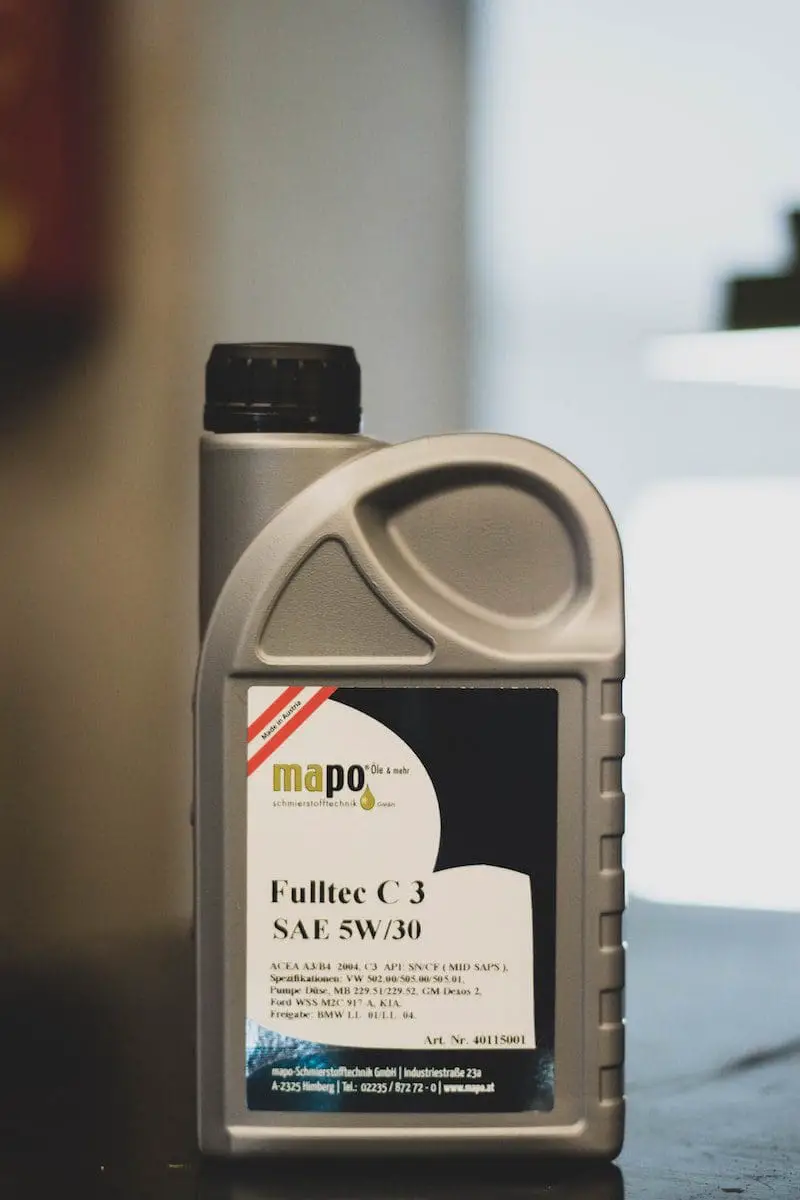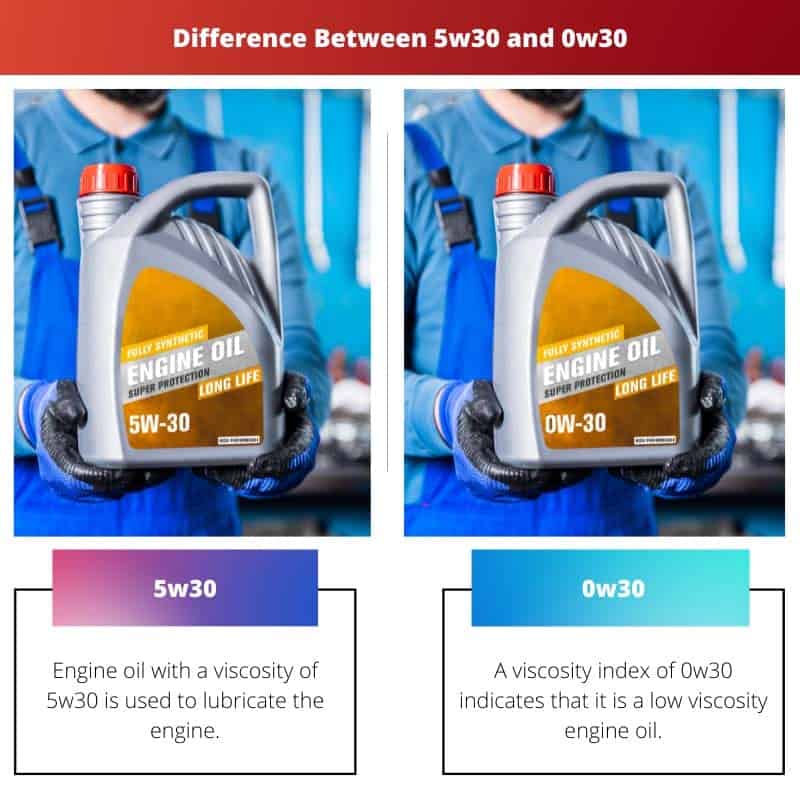Lubrication is required for any vehicle or automotive to run efficiently for an extended period. Each part of a car has its lubricating fuel that must be used for it to work properly.
Engines, too, have their lubrication oil. Being such a car owner necessitates a wide range of knowledge. Many components, ranging from motor oil to tires, contribute to better vehicle maintenance.
Key Takeaways
- 5W30 and 0W30 are multi-grade oils, with the former having a viscosity rating of 5 at cold temperatures and 30 at normal operating temperatures. In contrast, the latter has a viscosity rating of 0 at cold and 30 at normal operating temperatures.
- 0W30 provides better flow at extremely low temperatures than 5W30, ensuring superior cold-start performance.
- Although both oils are suitable for various vehicle engines, 0W30 is recommended for vehicles operating in colder climates or requiring improved fuel efficiency.
5w30 vs 0w30
The difference between 5w30 and 0w30 is that the 5W-30 Motor Oil has a higher viscosity than the 0W-30 Motor Oil, which is a unique type of motor oil. Because of its low viscosity, it can be used instead of 5W-30. The viscosity of motor oil aids in fast starting the engine, and the thickness of the oil fluctuates depending on the season.

Engine oil with a viscosity of 5w30 is used to lubricate the engine. The number 5 denotes the oil’s viscosity, with 1 denoting the lowest surface tension and thus the highest efficiency.
They have a low viscosity and can withstand a wide range of temperatures, making them ideal for a variety of vehicles.
A viscosity index of 0w30 indicates that it is a low viscosity engine oil. Compared to 10w30 engine oil, it is the thinnest oil at low temperatures. It’s perfect for cold weather.
Also, the average temperature is -40 to 86 degrees Fahrenheit. It’s also suitable for SUVs, compact vans, and pickup vehicles.
Comparison Table
| Parameters of Comparison | 5w30 | 0w30 |
|---|---|---|
| Viscosity Index | 5w30 motor engine oil has a viscosities of 154. | 0w30 has a viscosities of 167. |
| Weather suitability | 5w30 is ideal for hotter climates. | Winters are ideal for 0w30 oil. |
| Thickness | The motor engine oil in 5w30 is thick. | The lightest motor engine oil is 0w30. |
| Compatibility | Light-duty motors need 5w30 motor engine oil. | SUVs, compact vans, and lorries can all benefit from 0w30. |
| Temperature range | Over a temperature range of -35 to 35 degrees Celsius, it remains a thick liquid. | The temperature of 0w30 motor engine oil ranges from -40 to 86 degrees Fahrenheit. |
What is 5w30?
5w30 is a lubricant used in the engines of vehicles such as commercial vehicles. Consequently, motor oil is also known as SAE 5w30.
This is due to the Society of Automotive Engineering’s guidelines for naming and numbering vehicles.
The viscosity, appropriate weather, and viscosity of the fuel are all represented in the oil’s name. The thickness of the fuel in this situation is 5. With a viscosity of 1, this oil is thick enough for commercial vehicle engines.
These have the letter ‘w’ to indicate the weather because they hide the negative temperature scale. They are best used in the winter for autos since they have a thickness temperature of at least -35 degrees Celsius.
5w30 is one of the best oils for your engine, and it’s suitable for average or warm temperatures.
The number ‘5’ denotes viscosity, but the number 30 denotes the volume of other oils stored in hotter regions. In comparison to 5w20, it is a thicker and more viscous oil.
It creates more friction and moves more slowly, causing it to drag. Because the oil is thick, it does not evaporate, leaving the engine’s components exposed.
The motor is not worn out in the long run. It is not ideal for colder locations because lubricating the entire engine takes a long time.

What is 0w30?
0w30 is another motor engine oil, with 0 indicating viscosity at low temperatures and 30 indicating viscosity at high temperatures.
In the winter, a lower viscosity number is used in the vehicle engine oil, whereas in the summer, a higher viscosity number is utilized.
0w30 is a multiage oil that is primarily used in the winter because of its reduced viscosity, which allows for free circulation despite the cold.
It flows more freely in the winter because it is thinner, but it also aids in engine lubrication. It has a similar SAE rating to 0w30, 5w30, and 10w30 motor oil filters at higher temperatures.
Furthermore, it is commonly used in hard winters since the reduced viscosity allows for rapid oil circulation around the engine following ignition.
Also, with a viscosity index of 167, 0w30 has a relatively low viscosity, making it appropriate for tough winter weather conditions.
Because the oil is thinner in the winter and the average temp of the oil is between -40 and 86 degrees Fahrenheit, it is extremely efficient.
Moreover, 0w30 motor engine oil is suitable for SUVs, small vans, and vehicles and is best used in extremely low temperatures.
In terms of fuel economy, it is regarded as the best of all motor engine oils.
Meanwhile, the 0w30 has a considerable advantage in that it allows for quicker flow at ignition and reaches all regions of the engine immediately.

Main Differences Between 5w30 and 0w30
- 5w30 stays a viscous fluid throughout a wide range of temperatures of -35 to 35 degrees Celsius, whereas 0w30 motor engine oil has a range of temperature of -40 to 86 degrees Fahrenheit.
- 5w30 motor oil is recommended for light-duty engines, whereas 0w30 can be used in SUVs, small vans, and tractors.
- The viscosity of 5w30 motor engine oil is 154, whereas The viscosity of 0w30 is 167.
- For warm areas, 5w30 is suitable, whereas Winter is the best time to use 0w30 oil.
- The 5w30 motor engine oil is thick, whereas 0w30 is the least motor oil available.




